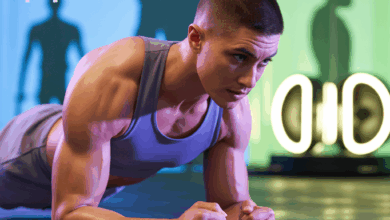Can You Workout on a Water Fast? A Practical Guide for Safe Exercise While Fasting

Have you ever considered skipping meals for a detox or weight-loss push — then wondered, “can you workout on a water fast” without collapsing mid-plank? It’s a common curiosity: you want the benefits of fasting but don’t want to give up your training. This article breaks down the risks, the smart strategies, and real-world workout options so you can make an informed, safe decision.
Why people try water fasting — and why exercise complicates things
Water fasting (consuming only water for a set time) is used for weight loss, metabolic reset, or spiritual reasons. Meanwhile, exercise relies on energy stores and hydration. Combining the two changes how your body fuels movement, affecting performance, recovery, and safety. Knowing how fast length, intensity, and fitness level interact helps you choose the right approach.
Can you workout on a water fast? What the science and experience say
Short answer: yes — sometimes. The reality depends on the length of the fast and the type of exercise. During a short water fast (12–24 hours), many people can handle low- to moderate-intensity workouts like walking, yoga, or light strength training. As fasting extends beyond 24–48 hours, glycogen stores drop and the body shifts to ketosis, which can reduce peak power and increase perceived exertion.
For most people, low-intensity steady-state (LISS) cardio and mobility work are realistic while fasting. High-intensity interval training (HIIT), heavy lifting, and long endurance sessions increase the risk of dizziness, fainting, or muscle catabolism when you’re not consuming calories.
Factors that influence safety and performance
- Length of fast: shorter fasts are easier to manage for exercise.
- Fitness level and experience with fasting: trained athletes and experienced fasters adapt better.
- Type of exercise: intensity and duration matter.
- Hydration and electrolytes: critical during water-only fasts.
- Individual health status: medical conditions may make fasting + exercise unsafe.
Practical tips for exercising safely on a water fast
If you decide to exercise while water fasting, follow these practical guidelines to protect your performance and health.
- Prioritize hydration: Drink plenty of water and consider electrolyte supplementation (sodium, potassium, magnesium) if you feel weak, crampy, or lightheaded.
- Start low and slow: Choose low-intensity workouts (walking, gentle cycling, restorative yoga) for fasted days, especially during the first 24–48 hours.
- Monitor intensity: Keep perceived exertion at a conversational pace. Avoid maximal lifts, sprints, or long high-volume sessions.
- Listen to your body: Stop if you feel dizzy, nauseous, extremely fatigued, or unusually irritable.
- Plan recovery: Expect slower recovery — prioritize sleep and rest days.
- Re-feed smartly: When you break the fast, choose nutrient-dense, easy-to-digest foods with protein and electrolytes to support muscle recovery.
- Consult a professional: Talk to a doctor or registered dietitian before attempting prolonged water fasts, especially if you have medical conditions.
Workout variations that work well on a water fast
Here are specific workout examples to match fast length and goals.
Short fast (12–24 hours)
- Morning brisk walk (20–45 minutes)
- Light resistance circuit: bodyweight squats, push-ups, glute bridges — 2–3 sets of low reps
- Gentle yoga flow for mobility and breathwork
Moderate fast (24–48 hours)
- Low-intensity steady-state cardio: easy cycling or walking 30–60 minutes
- Mobility and light resistance: focus on form, not load; reduce volume
- Breathing exercises and restorative yoga
Prolonged fast (>48 hours)
- Prioritize rest, gentle walks, and very light mobility work
- Avoid resistance training or intense cardio unless you are experienced and monitored
Real-world example: How one weekend faster handled workouts
Meet Sarah, a regular gym-goer who wanted to try a 36-hour water fast. She skipped heavy sessions and planned two low-intensity activities: a 30-minute brisk walk in the morning and a 20-minute mobility + bodyweight routine in the evening. She carried electrolyte tablets, stayed near home, and stopped immediately when she felt a light-headed spell. After breaking the fast with a gentle broth and protein-rich meal, she returned to normal training the next day. Her approach prioritized safety over pushing limits — a good model for beginners.
Signs you should stop exercising during a water fast
- Dizziness, blurred vision, or fainting
- Rapid heart rate or palpitations
- Severe nausea or vomiting
- Confusion, disorientation, or extreme weakness
If any of these occur, sit or lie down, hydrate, and seek medical attention if symptoms persist or worsen.
How to break a water fast to support fitness goals
Breaking a fast properly helps reduce gastrointestinal distress and supports muscle recovery:
- Start with liquids or easily digested foods: bone broth, diluted smoothies, or small portions of fruit.
- Introduce protein gradually: eggs, yogurt, or lean fish help reduce muscle breakdown;
- Include electrolytes and some carbohydrates to restore glycogen for your next workout.
Check out our internal nutrition guides for sample post-fast meals and recovery strategies.
Who should avoid working out on a water fast?
Skip exercising while fasting if you:
- Have diabetes, heart disease, low blood pressure, or are pregnant/breastfeeding
- Are new to fasting or high-intensity exercise
- Are underweight or trying to gain muscle mass
Medical supervision is essential for vulnerable individuals attempting extended fasts.
Frequently Asked Questions
Fasted cardio at low intensity (walking, easy cycling) is generally safe during short water fasts. High-intensity sessions increase risk of fatigue and muscle loss. Keep sessions short and monitor how you feel.
Short fasts paired with light exercise are unlikely to cause significant muscle loss. Prolonged fasting combined with intense training increases the risk of muscle catabolism — prioritize lower intensity and consider shorter fasts to preserve muscle.
Strict water-only fasting excludes any additives, but from a safety perspective, electrolytes (especially sodium and potassium) can be important if you experience dizziness or cramps. Discuss supplementation with a healthcare professional.
Conclusion: Can you workout on a water fast — and what should you do next?
So, can you workout on a water fast? Yes — but carefully. Match your exercise to the length of the fast and your fitness level: prioritize low-intensity movement, stay hydrated, monitor symptoms, and avoid loud pushing during prolonged fasts. If you want to experiment safely, try a short fast with gentle walks and mobility work, and use the tips above to recover smartly.
Ready to adapt your routine? Explore structured workout routines for low-intensity days, check our wellness tips for hydration and recovery, and consult a healthcare professional before attempting extended water fasts. If you found this helpful, try one week of mindful fasting + low-intensity movement, then share your results or questions in the comments — I’d love to hear how it goes.





